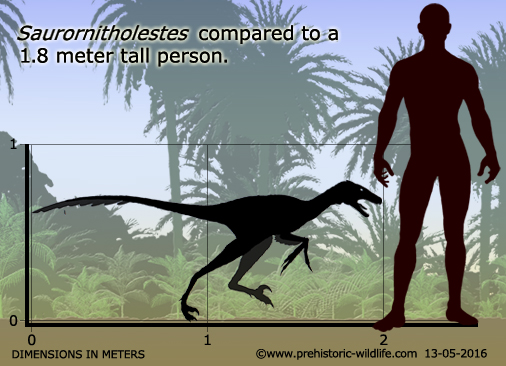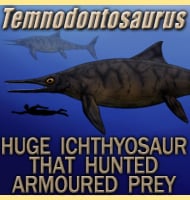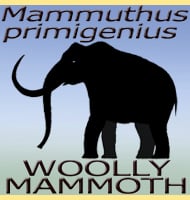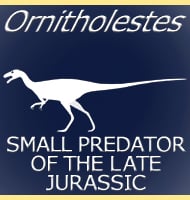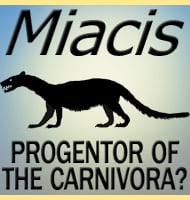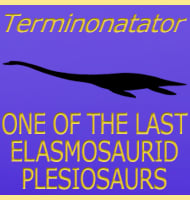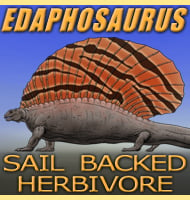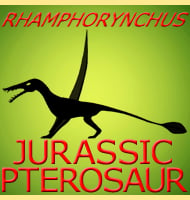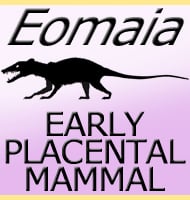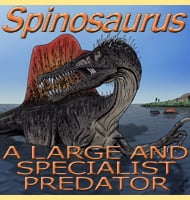In Depth
First discovered in the Canadian Province of Alberta by Irene Vanderloh in 1974 and named by Hans-Dieter Sues in 1978, Saurornitholestes was a small dromaeosaur that is thought to have been similar to the Asian Velociraptor in form. In 2006 a second species called Saurornitholestes robustus was named by Robert Sullivan. The ‘robustus’ part is in reference to the more robust build of the thicker bones of this specimen which indicates that this species was more heavily and powerfully built than the more northern types species S. langstoni.
Like with many other members of the Dromaeosauridae, Saurornitholestes would have had a small skull and jaws, but did possess the large sickle shaped claws that are a signature feature of this group that were probably the primary killing weapons. Saurornitholestes is usually depicted as a low level predator that would have focused upon hunting similarly sized dinosaurs and other small vertebrates like mammals and lizards. There is fossil evidence however that upon at least one occasion a Saurornitholestes fed upon the giant pterosaur Quetzalcoatlus, although the specimen of this pterosaur is thought to have come from a juvenile and hence smaller individual. It’s also possible that the Quetzalcoatlus in question may have already been dead and that the Saurornitholestes had scavenged the body, commonplace behaviour for predatory animals today that rarely pass up the chance for a free meal.
Saurornitholestes would have faced predatory competition from other small theropods like Dromaeosaurus and Troodon that were actually distantly related to Saurornitholestes. However none of these dinosaurs were the apex predators of Late Cretaceous North America, that title belongs to the tyrannosaurs and there is fossil evidence to lend some support to this. A dentary (lower jaw bone) from the Dinosaur Park Formation was described in 2001 by Aase Roland Jacobsen as having tooth marks in the form of grooves across the bone. Although the size and spacing of the marks is similar to that of another dromaeosaur, the shape is closer to that of tyrannosaur teeth. Together this leads to the conclusion that Saurornitholestes was eaten by a juvenile tyrannosaur, something which is actually quite likely when you consider that juvenile tyrannosaurs had proportionately longer legs than adults which means that they could have run faster by comparison and with some juvenile tyrannosaurs showing similar leg proportions to ornithomimid dinosaurs (thought to possibly be the fastest dinosaurs), a dromaeosaur like Saurornitholestes would have had no chance of escape by running away.
The exact culprit of this kill is still unknown, but two tyrannosaur genera that are from the Dinosaur Park Formation at the same time as Saurornitholestes are Daspletosaurus and Gorgosaurus (a third tyrannosaur called Albertosaurus is also known from this formation but from a later period in the Cretaceous). Gorgosaurus is of particular interest since this had a more gracile build than Daspletosaurus meaning it would likely have been the faster of the two. Southern populations of Saurornitholestes would have also had to live in the shadow of a different kind of tyrannosaur, the slightly shorter snouted Bistahieversor.
Further Reading
– A new small theropod dinosaur from the Judith River Formation (Campanian) of Alberta Canada. – Zoological Journal of the Linnean Society 62:381-400. – Hans-Dieter Sues – 1978. – Saurornitholestes robustus is a troodontid (Dinosauria: Theropoda). – Canadian Journal of Earth Sciences, v. 51, p. 730–734. – D. C. Evans, D. W. Larson, T. M. Cullen & R. M. Sullivan – 2014. – Cranial Anatomy of New Specimens of Saurornitholestes langstoni (Dinosauria, Theropoda, Dromaeosauridae) from the Dinosaur Park Formation (Campanian) of Alberta. – The Anatomical Record. 303 (4): 691–715. – Philip J. Currie & David C. Evans – 2020.
